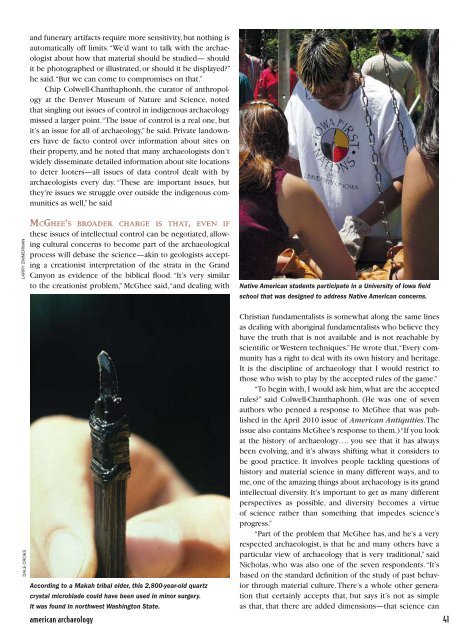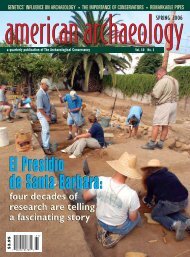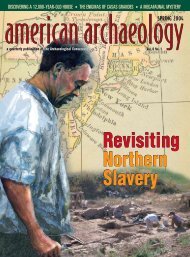Clovis Comet Debate - The Archaeological Conservancy
Clovis Comet Debate - The Archaeological Conservancy
Clovis Comet Debate - The Archaeological Conservancy
You also want an ePaper? Increase the reach of your titles
YUMPU automatically turns print PDFs into web optimized ePapers that Google loves.
larry zimmerman<br />
dale croeS<br />
and funerary artifacts require more sensitivity, but nothing is<br />
automatically off limits. “We’d want to talk with the archaeologist<br />
about how that material should be studied— should<br />
it be photographed or illustrated, or should it be displayed?”<br />
he said. “But we can come to compromises on that.”<br />
Chip Colwell-Chanthaphonh, the curator of anthropology<br />
at the Denver Museum of Nature and Science, noted<br />
that singling out issues of control in indigenous archaeology<br />
missed a larger point. “<strong>The</strong> issue of control is a real one, but<br />
it’s an issue for all of archaeology,” he said. Private landowners<br />
have de facto control over information about sites on<br />
their property, and he noted that many archaeologists don’t<br />
widely disseminate detailed information about site locations<br />
to deter looters—all issues of data control dealt with by<br />
archaeologists every day. “<strong>The</strong>se are important issues, but<br />
they’re issues we struggle over outside the indigenous communities<br />
as well,” he said<br />
mcgh e e’s b ro a d e r c h a rg e Is t h at , even If<br />
these issues of intellectual control can be negotiated, allowing<br />
cultural concerns to become part of the archaeological<br />
process will debase the science—akin to geologists accepting<br />
a creationist interpretation of the strata in the Grand<br />
Canyon as evidence of the biblical flood. “It’s very similar<br />
to the creationist problem,” McGhee said, “and dealing with<br />
According to a Makah tribal elder, this 2,800-year-old quartz<br />
crystal microblade could have been used in minor surgery.<br />
It was found in northwest Washington State.<br />
Native American students participate in a University of Iowa field<br />
school that was designed to address Native American concerns.<br />
Christian fundamentalists is somewhat along the same lines<br />
as dealing with aboriginal fundamentalists who believe they<br />
have the truth that is not available and is not reachable by<br />
scientific or Western techniques.” He wrote that, “Every community<br />
has a right to deal with its own history and heritage.<br />
It is the discipline of archaeology that I would restrict to<br />
those who wish to play by the accepted rules of the game.”<br />
“To begin with, I would ask him, what are the accepted<br />
rules?” said Colwell-Chanthaphonh. (He was one of seven<br />
authors who penned a response to McGhee that was published<br />
in the April 2010 issue of American Antiquities. <strong>The</strong><br />
issue also contains McGhee’s response to them.) “If you look<br />
at the history of archaeology…. you see that it has always<br />
been evolving, and it’s always shifting what it considers to<br />
be good practice. It involves people tackling questions of<br />
history and material science in many different ways, and to<br />
me, one of the amazing things about archaeology is its grand<br />
intellectual diversity. It’s important to get as many different<br />
perspectives as possible, and diversity becomes a virtue<br />
of science rather than something that impedes science’s<br />
progress.”<br />
“Part of the problem that McGhee has, and he’s a very<br />
respected archaeologist, is that he and many others have a<br />
particular view of archaeology that is very traditional,” said<br />
Nicholas, who was also one of the seven respondents. “It’s<br />
based on the standard definition of the study of past behavior<br />
through material culture. <strong>The</strong>re’s a whole other generation<br />
that certainly accepts that, but says it’s not as simple<br />
as that, that there are added dimensions—that science can<br />
american archaeology 41




